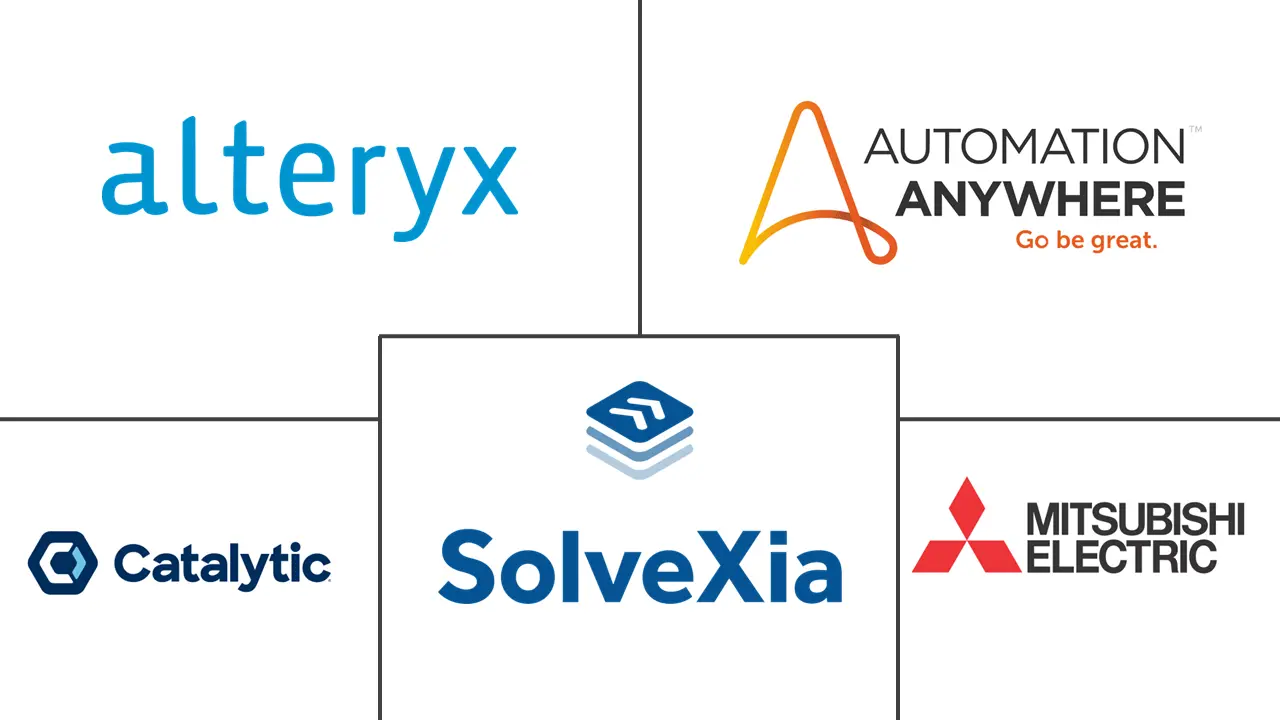Hyperautomation Market Size and Share
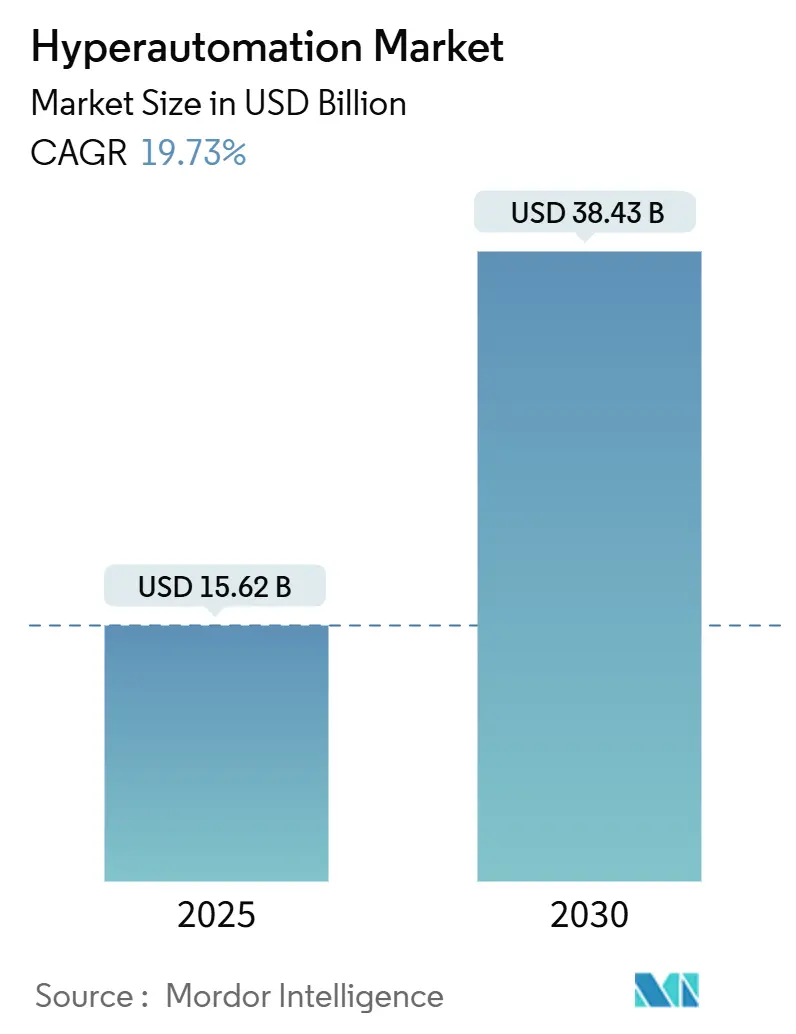
Hyperautomation Market Analysis by Mordor Intelligence
The hyper automation market size reached USD 15.62 billion in 2025 and is projected to hit USD 38.43 billion by 2030, advancing at a 19.73% CAGR, underscoring sustained enterprise appetite for broad-based intelligent automation. Demand is rising as companies tackle persistent labor shortages, regulatory pressure, and margin compression, steering budgets toward end-to-end workflow orchestration rather than isolated task automation. Robust platform convergence, especially the fusion of AI with robotic process automation, has made cognitive decisioning a baseline expectation, while low-code tools now let business users build automations without deep technical skills. Vendors differentiate on embedded generative AI, process-mining accuracy, and industry-specific accelerators that shorten proof-of-value cycles. At the same time, boards view hyper automation deployment as a hedge against future skills gaps, inserting the topic firmly into strategic investment roadmaps across manufacturing, financial services, healthcare, and retail ecosystems.
Key Report Takeaways
- By component, solutions captured 61.23% of hyper automation market share in 2024, whereas services are on track for a 20.31% CAGR through 2030.
- By technology type, robotic process automation led with 39.33% revenue share in 2024; process and task mining is forecast to expand at a 28.74% CAGR to 2030.
- By deployment mode, on-premise accounted for 54.21% of the hyper automation market size in 2024, while cloud deployment is advancing at a 23.21% CAGR through 2030.
- By end-user enterprise size, large enterprises held 68.71% of the hyper automation market share in 2024; small and mid-sized enterprises are growing at a 22.11% CAGR to 2030.
- By end-user industry, BFSI controlled 27.46% revenue share in 2024; healthcare is projected to accelerate at a 24.81% CAGR through 2030.
- By geography, North America led with 36.67% market share in 2024, while the Asia Pacific is set to rise at a 19.42% CAGR over the forecast horizon.
Global Hyperautomation Market Trends and Insights
Drivers Impact Analysis
| Driver | (~) % Impact on CAGR Forecast | Geographic Relevance | Impact Timeline |
|---|---|---|---|
| Rising industrial automation initiatives | +3.2% | Global (Asia Pacific leading) | Medium term (2-4 years) |
| Digital-first enterprise strategies for cost optimization | +2.8% | North America and EU, spreading to Asia Pacific | Short term (≤2 years) |
| Rapid adoption of RPA-AI convergence platforms | +4.1% | Global in developed markets | Short term (≤2 years) |
| Skill-gap driven demand for low-code citizen-developer tools | +2.3% | Global, strongest in SME segment | Medium term (2-4 years) |
| Process-mining-led self-optimizing workflows | +3.7% | North America and EU enterprises | Medium term (2-4 years) |
| Edge-enabled hyperautomation in connected factories | +2.1% | Asia Pacific, Germany, United States | Long term (≥4 years) |
| Source: Mordor Intelligence | |||
Rising Industrial Automation Initiatives
Manufacturers now embed the hyper automation market’s toolset across production lines to remedy supply-chain shocks and worker scarcity observed after 2024. Coca-Cola’s Singapore lighthouse plant lifted throughput 28% and labor productivity 70% by merging predictive scheduling with computer-vision quality control[1]World Economic Forum. "Case Study Details - Global Lighthouse Network - The Coca-Cola Company - Singapore." June 8, 2024. . Textile producer Delta Galil harnessed RFID insights to benchmark line-level efficiency and spark inter-team competition, shrinking downtime and boosting yields. Hyper automation reaches beyond robotics by logging granular asset data, feeding machine-learning models that flag anomalies before they disrupt production. That shift from reactive to predictive maintenance reduces scrap, lengthens equipment life, and improves schedule adherence, making investment cases compelling even in cost-sensitive environments. Enterprises increasingly standardize data capture at the edge, enabling centralized analytics that iterate process tweaks in near real time.
Digital-First Enterprise Strategies for Cost Optimization
Board mandates for structural cost take-out now demand redesign of core workflows rather than piecemeal savings. Companies replacing manual invoice handling, claims adjudication, and customer onboarding report triple-digit ROI inside 12 months, driven by lower error rates and faster cycle times. Ring Container’s deployment of AI-infused automation shaved USD 102,000 annually from freight paperwork processing and accelerated customer inquiry resolution by 96%[2]Infor. "12K+ hr savings/yr in production & warehouse with Infor EA & Infor AI." May 3, 2024. . These initiatives redirect labor toward higher-value analysis and innovation, fortifying customer loyalty through shorter time-to-market. Hyper automation further underpins data-driven revenue plays such as dynamic pricing and personalized offers, reinforcing its position as a catalyst for both cost and top-line gains.
Rapid Adoption of RPA-AI Convergence Platforms
The hyper automation market pivoted sharply once generative AI models could interpret unstructured documents, summarize content, and reason over context. Automation Anywhere stated that more than 70% of 2024 bookings reflected AI-powered bots able to draft emails, classify contracts, and trigger downstream actions without human routing[3]Automation Anywhere. "Automation Anywhere Surpasses Second Quarter Goals with Accelerating Momentum After Successful Autonomous AI Agent Launch and Early Customer Wins." September 11, 2024. . Microsoft’s integration of Azure OpenAI Service lets staff build automations through natural-language prompts, lowering entry barriers and widening user participation. The result is an end-to-end workflow fabric where rules-based bots escalate ambiguous cases to cognitive agents that learn continuously, shrinking exception queues and amplifying business agility.
Skill-Gap Driven Demand for Low-Code Citizen-Developer Tools
Acute shortages of integration talent raise project backlogs, prompting firms to empower business specialists as “citizen developers.” SAP Build users recorded 40% cost reductions when expanding ERP extensions via drag-and-drop components, proof that domain experts can automate safely without writing code. Visual flow designers, template libraries, and AI code co-pilots let finance, HR, and supply-chain teams prototype solutions in days, which IT then hardens for enterprise-grade scale. Democratization accelerates adoption in the small and mid-sized cohort that lacks large IT budgets yet still seeks hyper automation market gains in accuracy, compliance, and cycle time.
Restraints Impact Analysis
| Restraint | (~) % Impact on CAGR Forecast | Geographic Relevance | Impact Timeline |
|---|---|---|---|
| High upfront investment requirements | -2.1% | Global, sharpest for SMEs | Short term (≤2 years) |
| Shortage of integration talent | -1.8% | Global, acute in mature markets | Medium term (2-4 years) |
| Data-sovereignty barriers to cloud deployment | -1.3% | EU and regulated sectors | Medium term (2-4 years) |
| Algorithmic-transparency compliance delays | -0.9% | EU AI-Act regions, expanding | Long term (≥4 years) |
| Source: Mordor Intelligence | |||
High Upfront Investment Requirements
Comprehensive hyper automation programs require sizable capital software, infrastructure upgrades, and change-management spending that can dwarf ordinary IT refresh cycles. SAP budgeted EUR 2 billion (USD 2.18 billion) restructuring outlays to unlock AI-driven efficiencies, illustrating the scale facing Fortune 500 peers. Mid-market firms often struggle to finance similar journeys despite compelling payback models, forcing phased rollouts or managed-service engagements. The sticker shock also includes training existing staff, re-engineering processes, and integrating legacy systems, making clear executive sponsorship essential to cross the investment hurdle.
Shortage of Integration Talent
Demand for versatile engineers who can stitch together APIs, event streams, and legacy protocols far outstrips supply, lengthening project timelines. As hyper automation expands from single processes to enterprise-wide operating models, complexity escalates, requiring scarce hybrid skills in process design and AI model tuning. Large enterprises outbid smaller rivals for expertise, inflating wage costs and creating delivery bottlenecks. The vendor response is pre-packaged connectors and AI-generated integration scripts, yet bespoke tailoring remains unavoidable for regulated workflows and on-premise ERPs. Without a strategic talent pipeline, organizations risk stalled initiatives and unrealized value.
Segment Analysis
By Component: Solutions Dominance Drives Platform Consolidation
Solutions retained 61.23% of the hyper automation market share in 2024 as enterprises gravitated toward unified suites that bundle process discovery, orchestration, and analytics. Vendor roadmaps emphasize modular architectures so customers can activate new capabilities without large-scale re-implementations. Services, however, are growing faster at 20.31% CAGR because organizations increasingly rely on external experts to customize deployments and manage iterative optimization. Advisory partners design governance frameworks, center-of-excellence models, and ROI dashboards, ensuring business outcomes outweigh feature checklists. Managed services gain traction where internal teams lack round-the-clock talent, shifting cost from capital budgets to predictable operating expense.
Professional services further expand the hyper automation market size by de-risking global rollouts through accelerate-to-value methodologies, industry-specific templates, and post-go-live monitoring. Providers bundle change-management coaching with technical delivery, helping staff adapt to new human-bot collaboration patterns. The move toward outcome-based pricing aligns incentives, with service firms staking fees on productivity benchmarks, fueling a virtuous cycle of continuous improvement and deeper platform penetration.
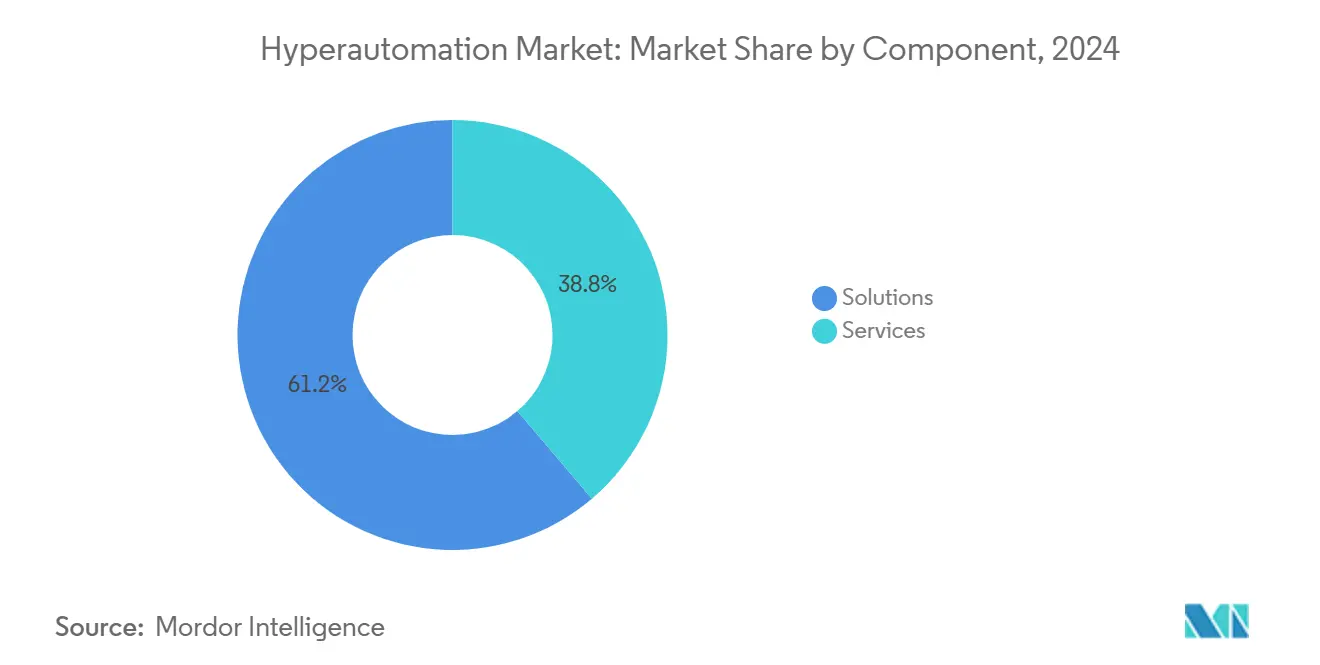
By Technology Type: Process Mining Disrupts Traditional RPA Leadership
Robotic process automation held 39.33% revenue in 2024, yet process and task mining’s 28.74% CAGR signals an analytic-first era where data-derived insights guide investment order. Mining tools scrutinize event logs to surface fragmentation, latency, and compliance deviations, translating findings into automation candidate pipelines with quantified savings potential. Machine-learning and deep-learning components amplify this discovery by predicting volume spikes, exception scenarios, and failure likelihood, informing dynamic resource allocation. Natural-language interfaces allow business analysts to query process maps conversationally, widening access to optimization insights.
Computer-vision modules extend the hyper automation market beyond back-office screens to physical-world inspection, identity verification, and inventory checks. Chatbots, powered by large language models, blend empathetic dialogue with transactional execution, elevating customer experience. Collectively, these converging technologies push vendors to offer plug-and-play orchestration layers that support heterogeneous engines, ensuring clients can evolve stacks without lock-in.
By Deployment Mode: Cloud Acceleration Challenges On-Premise Dominance
On-premise deployments commanded 54.21% share in 2024 due to data-sovereignty mandates and existing infrastructure sunk costs, especially among banks and governments. Yet cloud’s 23.21% CAGR shows perception shifts as providers certify platforms for stringent compliance frameworks such as FedRAMP and ISO 27001. Consumption-based pricing eliminates server capital expenditure and speeds provisioning, appealing to lines-of-business pursuing rapid pilots. Hybrid models emerge as a pragmatic bridge, keeping sensitive data processing local while exploiting elastic cloud for development, testing, and low-risk workloads.
European firms adhere to the EU’s evolving AI Act, often localizing compute within national borders or trusted-cloud zones. Meanwhile, retailers and technology companies migrate whole workloads to public cloud, leveraging regional availability zones for latency-sensitive use cases like fraud detection. As defense-grade encryption and confidential computing mature, barriers to cloud-hosted hyper automation shrink, encouraging vendors to prioritize multi-tenant SaaS roadmaps.
By End-user Enterprise Size: SME Growth Challenges Large Enterprise Dominance
Large enterprises held 68.71% of the hyper automation market size in 2024, buoyed by budget heft and legacy modernization roadmaps. Their scale justifies center-of-excellence constructs that nurture bot libraries across finance, HR, and supply-chain domains. Conversely, SMEs post a brisk 22.11% CAGR thanks to subscription-based offerings with intuitive design studios that slash entry complexity. Vendors court this segment with step-by-step wizards, outcome calculators, and bundled support hours, allowing lean teams to automate invoice capture, payroll, and inventory reconciliation.
SMEs favor cloud deployment and pay-as-you-go licensing, freeing cash for growth initiatives. Many start with a single process that pays for itself within one quarter, then reinvest savings into adjacent automations, fostering compounding efficiency gains. Large enterprises, in turn, look beyond internal savings to ecosystem playbooks that extend bots to suppliers and partners, unlocking network effects.
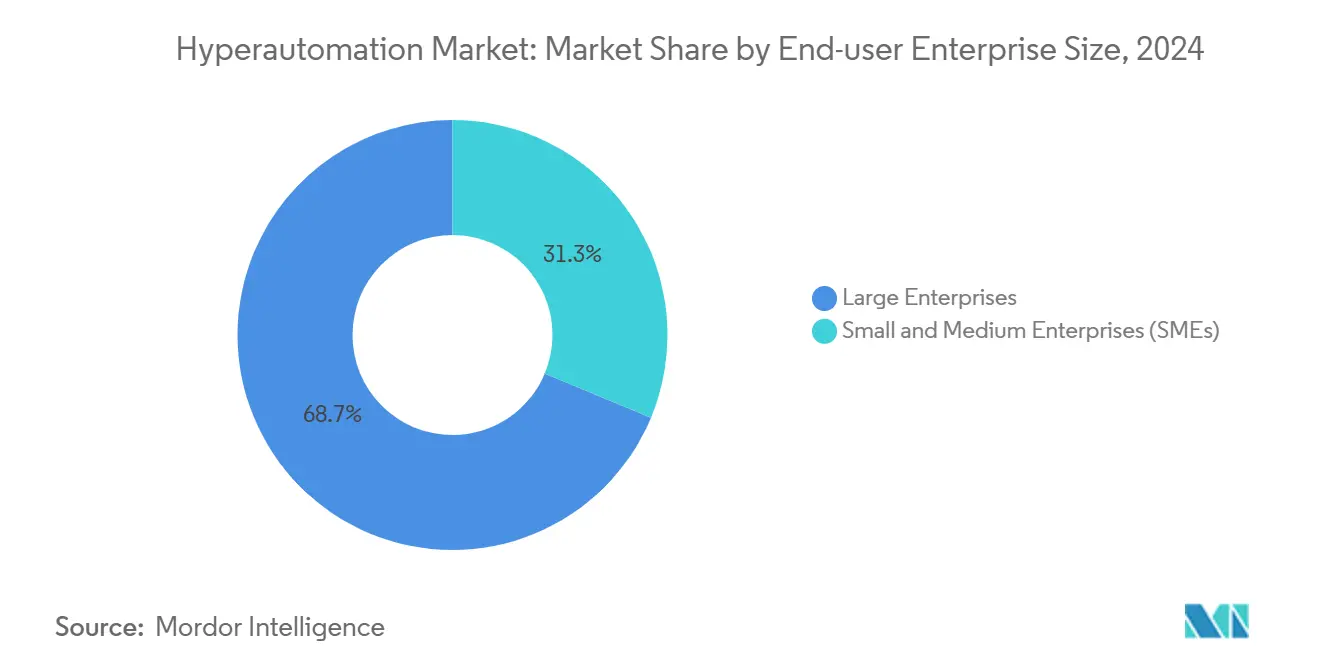
By End-User Industry: Healthcare Acceleration Challenges BFSI Leadership
BFSI preserved a 27.46% revenue foothold in 2024, safeguarding compliance, KYC, and high-volume transaction integrity with straight-through processing. Core-banking mergers and real-time payments amplify the need for zero-touch reconciliation and continuous risk monitoring. Healthcare, expanding at 24.81% CAGR, directs hyperautomation toward patient intake, prior-authorization, and claims coding, alleviating clinician burnout and tightening reimbursement cycles. An Illinois health system trimmed prior-auth turnaround from 72 hours to 6 minutes after integrating AI classification and smart forms, freeing staff for care coordination.
Manufacturing and automotive players overlay hyperautomation with IoT telemetry to detect micro-stoppages, sequence production orders dynamically, and trigger automated spare-parts procurement, bolstering overall equipment effectiveness. Retailers automate click-to-collect orchestration, returns handling, and personalized offers, enhancing customer loyalty. Educational institutions deploy chatbots for admissions queries and transcript processing, channeling administrative savings into digital learning experiences.
Geography Analysis
North America held 36.67% hyper automation market share in 2024, anchored by deep enterprise budgets, venture capital ecosystems, and seasoned automation talent pools. U.S. healthcare provider Dexcom saved 200,000 hours annually and cut cycle times 80% by harnessing AI-enabled bots inside finance and supply-chain teams. Financial regulators’ emphasis on operational resilience further accelerates uptake across banking and insurance. Canada complements with manufacturing use cases in automotive parts and food processing, while Mexico advances border-zone smart factories, showcasing cross-regional supply-chain orchestration.
Asia Pacific posts the fastest trajectory at 19.42% CAGR to 2030, invigorated by state-sponsored Industry 4.0 funds, large-scale electronics hubs, and competitive wage pressures. China’s provincial grants subsidize hyper automation adoption in textiles and logistics, while Japan embeds cognitive quality control in automotive paint shops. India leverages bots to enhance BPO accuracy and reduce average handling time for global clients. Australia stands out: 96% of enterprises reported automation plans spanning finance, HR, and customer service, indicating near-universal intent. ASEAN manufacturers deploy edge analytics to cut energy costs and meet export quality mandates.
Europe balances innovation with governance, guided by the AI Act that classifies hyper automation applications by risk category and stipulates transparency, bias mitigation, and human-in-the-loop provisions. Germany leads industrial transformation, embedding process-mining dashboards in discrete manufacturing plants. The United Kingdom positions hyper automation as a lever for competitive post-Brexit trade facilitation, emphasizing customs clearance automation. France pilots hospital workflow bots to relieve administrative overload, while Italy incentivizes SME adoption through tax credits linked to digitalization milestones.
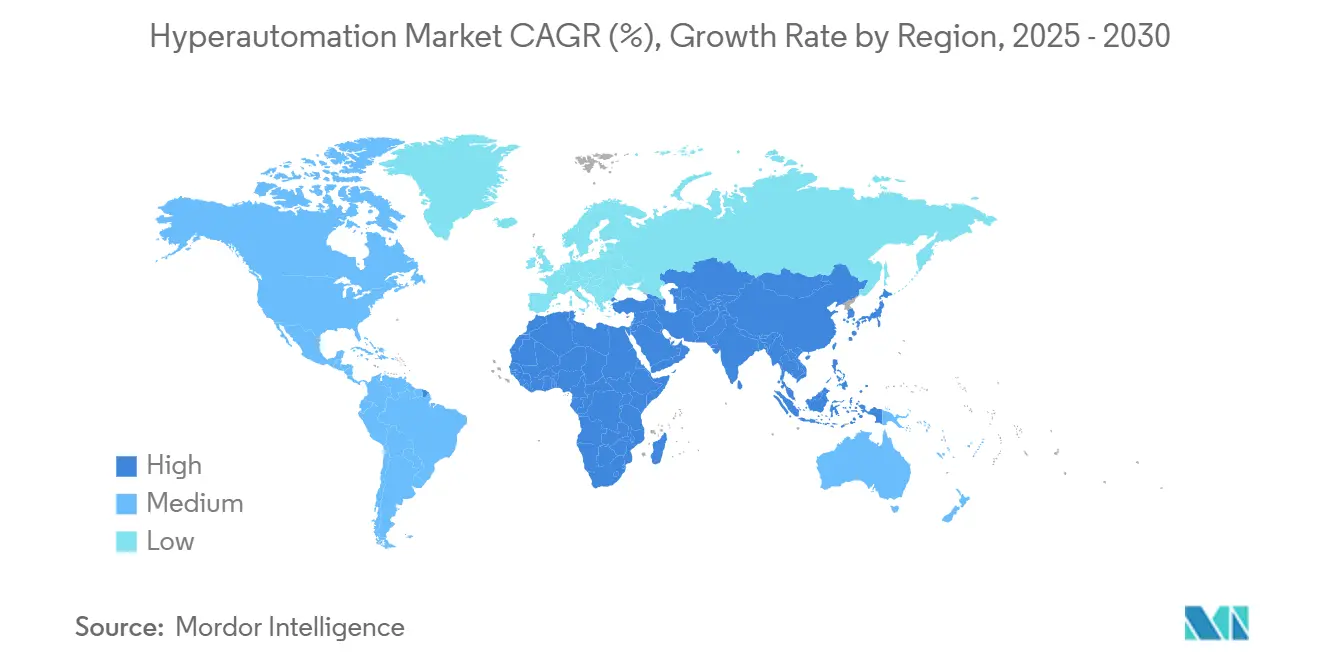
Competitive Landscape
The hyper automation market reflects moderate concentration, with a core cluster of platform vendors, cloud hyperscalers, and ERP stalwarts jostling for end-to-end wallet share. UiPath, Microsoft, and Automation Anywhere embed large-language-model agents that interpret unstructured data, authorize next-best actions, and converse with users, elevating value beyond click-stream replication. SAP, IBM, and Oracle capitalize on their ERP footprints, bundling process discovery and orchestration into subscription tiers to secure incumbency. ServiceNow’s USD 2.85 billion acquisition of Moveworks demonstrates hyperscale ambition to weave conversational AI into IT service workflows.
Competitive dynamics increasingly reward vertical depth; healthcare-focused newcomers craft HIPAA-compliant templates, while banking specialists bake in AML rule sets and audit trails. Edge-native startups fuse computer vision with industrial robots, reaching brownfield factories that require localized processing. Pricing models shift toward outcome-based contracts where vendors stake margins on SLA adherence, cementing long-term alliances and raising switching costs. Partner ecosystems blossom as global systems integrators launch hyper automation studios, co-developing accelerators aligned to industry governance.
Mergers and acquisitions inflows remain brisk: Circus SE purchased FullyAI for EUR 1.1 billion to inject agentic AI into hospitality robots, and BP3 secured USD 33 million to scale intelligent document processing services. Investment flows confirm analyst expectations that platform consolidation will intensify, with winners defined by seamless multimodal AI, open APIs, and demonstrable productivity gains.
Hyperautomation Industry Leaders
-
Alteryx
-
Automation Anywhere
-
SolveXia
-
Mitsubishi Electric Corporation
-
Catalytic Inc
- *Disclaimer: Major Players sorted in no particular order
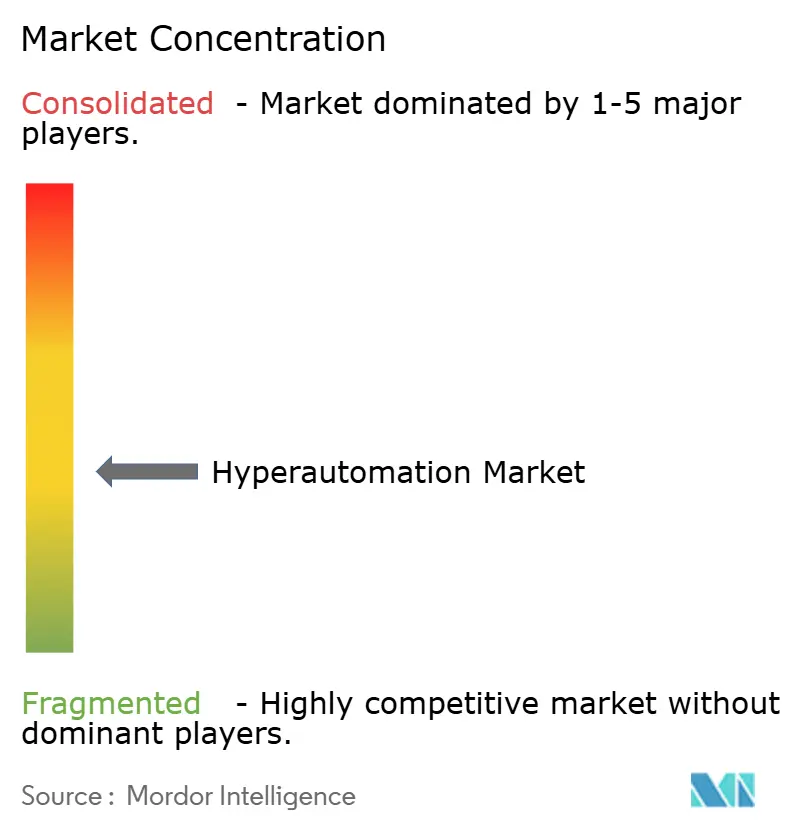
Recent Industry Developments
- May 2025: Circus SE agreed to acquire FullyAI for EUR 1.1 billion (USD 1.20 billion) to embed agentic AI in food-service robots.
- December 2024: HuLoop Automation closed a USD 6 million Series A round to advance unified intelligent automation software.
- November 2024: Automation Anywhere formed a strategic alliance with PwC India to co-deliver GenAI-powered automation across multiple industries
- October 2024: Luminai raised USD 21.57 million in Series A funding to scale AI-driven automation for healthcare and financial services.
- September 2024: Automation Anywhere posted a fourth consecutive quarter of operating income, with 70% of new bookings tied to AI-rich solutions.
- June 2024: SirionLabs acquired Eigen Technologies, lifting valuation above USD 1 billion and fortifying NLP capabilities.
- January 2024: Automation Anywhere partnered with Odin AI to expand enterprise AI agent capabilities and drive integrated automation uptake.
Global Hyperautomation Market Report Scope
Hyperautomation comprises increasing the automation of business processes (production chains, workflows, marketing processes, etc.) by introducing Artificial Intelligence, Machine Learning, and Robotic Process Automation.
The hyperautomation market is segmented by technology type (Biometrics, Machine Learning, Context-Aware Computing, Natural Learning Generation, Chatbots, Robotic Process Automation), by end-user industry (BFSI, Retail, IT & Telecom, Education, Automotive, Manufacturing, Healthcare & Life Science), and by Geography (North America, Europe, Asia Pacific, Latin America, Middle East and Africa). The market sizes and forecasts are in terms of value (USD million) for all the above segments.
| Solutions |
| Services |
| Robotic Process Automation (RPA) |
| Machine Learning and Deep Learning |
| Natural Language Processing and Chatbots |
| Process and Task Mining |
| Computer Vision and Biometrics |
| On-premise |
| Cloud |
| Hybrid |
| Large Enterprises |
| Small and Mid-Sized Enterprises (SMEs) |
| BFSI |
| Retail and e-Commerce |
| IT and Telecom |
| Manufacturing and Automotive |
| Healthcare and Life Sciences |
| Education |
| Others End-user Industry |
| North America | United States | |
| Canada | ||
| Mexico | ||
| South America | Brazil | |
| Argentina | ||
| Rest of South America | ||
| Europe | Germany | |
| United Kingdom | ||
| France | ||
| Italy | ||
| Spain | ||
| Russia | ||
| Rest of Europe | ||
| Asia Pacific | China | |
| Japan | ||
| India | ||
| South Korea | ||
| ASEAN-5 | ||
| Australia and New Zealand | ||
| Rest of Asia Pacific | ||
| Middle East and Africa | Middle East | United Arab Emirates |
| Saudi Arabia | ||
| Rest of Middle East | ||
| Africa | South Africa | |
| Nigeria | ||
| Rest of Africa | ||
| By Component | Solutions | ||
| Services | |||
| By Technology Type | Robotic Process Automation (RPA) | ||
| Machine Learning and Deep Learning | |||
| Natural Language Processing and Chatbots | |||
| Process and Task Mining | |||
| Computer Vision and Biometrics | |||
| By Deployment Mode | On-premise | ||
| Cloud | |||
| Hybrid | |||
| By End-User Enterprise Size | Large Enterprises | ||
| Small and Mid-Sized Enterprises (SMEs) | |||
| By End-User Industry | BFSI | ||
| Retail and e-Commerce | |||
| IT and Telecom | |||
| Manufacturing and Automotive | |||
| Healthcare and Life Sciences | |||
| Education | |||
| Others End-user Industry | |||
| By Geography | North America | United States | |
| Canada | |||
| Mexico | |||
| South America | Brazil | ||
| Argentina | |||
| Rest of South America | |||
| Europe | Germany | ||
| United Kingdom | |||
| France | |||
| Italy | |||
| Spain | |||
| Russia | |||
| Rest of Europe | |||
| Asia Pacific | China | ||
| Japan | |||
| India | |||
| South Korea | |||
| ASEAN-5 | |||
| Australia and New Zealand | |||
| Rest of Asia Pacific | |||
| Middle East and Africa | Middle East | United Arab Emirates | |
| Saudi Arabia | |||
| Rest of Middle East | |||
| Africa | South Africa | ||
| Nigeria | |||
| Rest of Africa | |||
Key Questions Answered in the Report
What is the current valuation of the hyper automation market?
The hyper automation market size stood at USD 15.62 billion in 2025.
How fast is the market expected to expand over the next five years?
It is forecast to reach USD 38.43 billion by 2030, registering a 19.73% CAGR.
Who are the key players in Hyperautomation Market?
Alteryx, Automation Anywhere, SolveXia, Mitsubishi Electric Corporation and Catalytic Inc are the major companies operating in the Hyperautomation Market.
Which component segment is growing the quickest?
Services are advancing at a 20.31% CAGR as enterprises seek implementation and managed-service expertise.
Which technology type is projected to outpace others?
Which technology type is projected to outpace others? Process and task mining is forecast at a 28.74% CAGR, reflecting demand for data-driven process discovery.
Which region is likely to lead future growth?
Asia Pacific shows the highest growth momentum with a 19.42% CAGR to 2030, propelled by Industry 4.0 programs and manufacturing digitization.
Which industry vertical will grow fastest?
Healthcare is projected to expand at a 24.81% CAGR as providers automate patient workflows and regulatory tasks.
Page last updated on:
